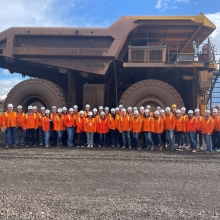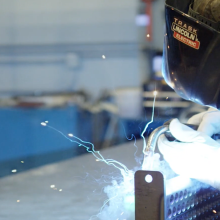2022 Business Benchmarks report: Infrastructure
Infrastructure in Minnesota
Featuring:
Bob Nuss, President, Nuss Truck and Equipment

A strong statewide network of infrastructure is necessary to move goods and services throughout the state. Minnesota is a connection point for the upper Midwest, and there is a vast network of businesses that rely on a sound system of connections in the air, the water, the roads and digital stratosphere.
“I’ve been in this business 50 years,” said Bob Nuss, President of Nuss Truck and Equipment. Nuss is a third-generation family-owned business experiencing vast growth. They’ve come a long way since their humble roots in a repair shop in 1959. In addition to their Rochester headquarters, they operate in eight locations in Minnesota and Wisconsin, soon to add a ninth. Their business is the epitome of infrastructure: from the smallest gasket to the biggest rigs on the road, Nuss sells each to companies of all types.
It’s about moving that product and outfitting the trucks that move on those roads. But it’s also about connectivity. “We have remote technicians who are working with either customers’ trucks or construction equipment in areas where there’s no internet,” says Nuss. “People live in these cities and it’s important to maximize uptime everywhere.”

Like many other businesses, Nuss was deemed essential in the COVID-19 pandemic with strong safety measures in place to serve their customers. They responded to the shifting needs of the COVID economy for the last year and a half, pivoting the types of products to specific clients.
Meeting client needs has meant facing challenges head-on, from supply chain to border closures and inflation. There is an evolving landscape of part shortages that have caused longer lead times and production delays. A hold-up on one single product can render a truck unusable for unknown amounts of time. And used truck pricing in the heavy-duty business has skyrocketed. But growth is good for business, and Nuss seeks to continually improve to meet demand. As the economy – in Minnesota, across the region and the nation – moves out of the COVID-19 pandemic, businesses need to move supplies and products across roadways and other elements of infrastructure.
Infrastructure in Minnesota: Ongoing improvements
Even when some business were ordered to shutter early in the pandemic citing health and safety, Minnesota’s infrastructure was moving the economy along. Now, as the state – and nation – recover from COVID-related impacts, each element of the state’s infrastructure; air, water, roads and digital connectivity, plays a critical role. Improved highway performance has made those who rely on Minnesota roads to do business more resilient. But widespread reliance on broadband has called attention to the inadequacies in Minnesota’s network. States with less landmass have an easier time reaching rural businesses and citizens, and have seen their rankings improve faster than Minnesota, even though Minnesota private and public sectors have dedicated significant resources to improving access in the state.










